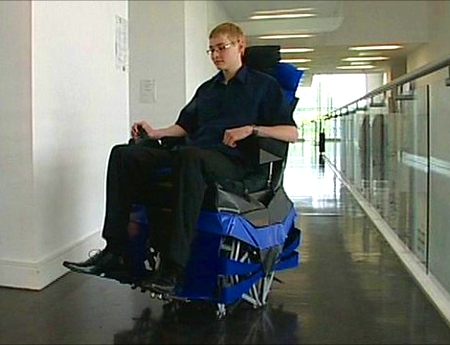Student Invents ‘Walking Chair’

A product-design student in Derby, England, has invented a wheel-chair alternative he hopes will give people with mobility issues more freedom, the BBC reported. Martin Harris, 21, noted that current wheelchairs are often restricted to paths. His battery-powered device “can work either indoors or outdoors – a leg can simply pick itself up and step over an obstacle.”
The chair, which can be steered by a joystick in the armrest, has six pairs of legs underneath the seat that consist of 216 pieces bolted together. Two conventional wheelchair motors power the “walking” chair, which can travel at up to 6.4 km/h (4 mph) – the maximum allowed for battery-powered wheelchairs.
Harris says the chair can negotiate almost any surface, including dirt, sand, grass, carpet, polished floors, and even moderate slopes. What inspired him to design such a chair? Strandbeast, a kinetic sculpture by Dutch artist and engineer Theo Jansen, famous for creating skeletons and sculptures that can walk on beaches.
Read Engineering as Art, our eGFI students’ blog posting about Theo Jansen and his designs.
Watch Strandbeast in motion:
[youtube]http://www.youtube.com/watch?v=HSKyHmjyrkA[/youtube]
Harris chose to use Jansen’s mechanism, which has been developed over years, in a wheelchair “to provide a practical purpose for it.” He sees many potential other uses for his invention, including in agricultural machinery or military vehicles.
Filed under: K-12 Education News, Special Features
Tags: adaptive technologies, Biomedical, Biomedical Engineering, Design, Mechanical engineering, student invention








